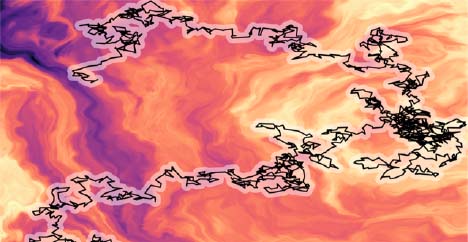A scientific competition assesses methods for anomalous diffusion
The study analyzes the results of a community effort and determines that machine learning greatly improves the estimation of the properties of diffusing particles.
Since Albert Einstein provided a theoretical foundation for Robert Brown’s observation of the erratic or unpredictable movement of microscopic particles suspended within pollen grains, significant new findings that deviate quite a bit from the laws of Brownian motion have been uncovered in a variety of animate and inanimate systems, from biology to the stock market.
Anomalous diffusion, as it has come to be called, extends the concept of Brownian motion and is connected to disordered systems, non-equilibrium phenomena, flows of energy and information, and transport in living systems. Several methods for detecting the occurrence of anomalous diffusion have been developed using classical statistics. However, in the last years, the booming of machine learning has boosted the development of data-based methods to characterize anomalous diffusion from single trajectories, providing more refined tools for this problem.

Now, a group of scientists led by researchers from the University of Vic – Central University of Catalunya (Uvic-UCC) and ICFO, in collaboration with colleagues from the University of Gothenburg, the University of Potsdam, and the Universitat Politècnica de València, has provided the first assessment of conventional and novel methods for quantifying anomalous diffusion in a variety of realistic conditions through a community-based effort. The results of the assessment have been recently published in Nature Communications.
During the past year, the researchers launched an open competition to benchmark existing methods and to spur the invention of new approaches. The Anomalous Diffusion (AnDi) Challenge brought together a vibrating and multidisciplinary community of scientists working on this problem, involving more than 30 participants from 22 institutions and 11 countries. Ultimately, the analysis of the results obtained on a reference dataset provided an objective assessment of the performance of methods to characterize anomalous diffusion from single trajectories for three specific tasks: anomalous exponent inference, model classification, and trajectory segmentation.
“The results of this study further highlight the central role that anomalous diffusion has in defining biological functions at multiple scales while revealing insight into the current state of the field and providing a benchmark for future developers” states Dr. Carlo Manzo, corresponding author of the study.
This research definitively contributes to the definition of a palette of tools and measures having the capacity of becoming standard methods for the analysis of trajectories generated from a variety of experiments, from atomic physics to ecology. The outcome of this study reinforces the importance of community-based efforts in the search for the advancement of science.
Reference: Muñoz-Gil et al.: “Objective comparison of methods to decode anomalous diffusion” published in Nature Communications on October 29, 2021. doi: 10.1038/s41467-021-26320-w